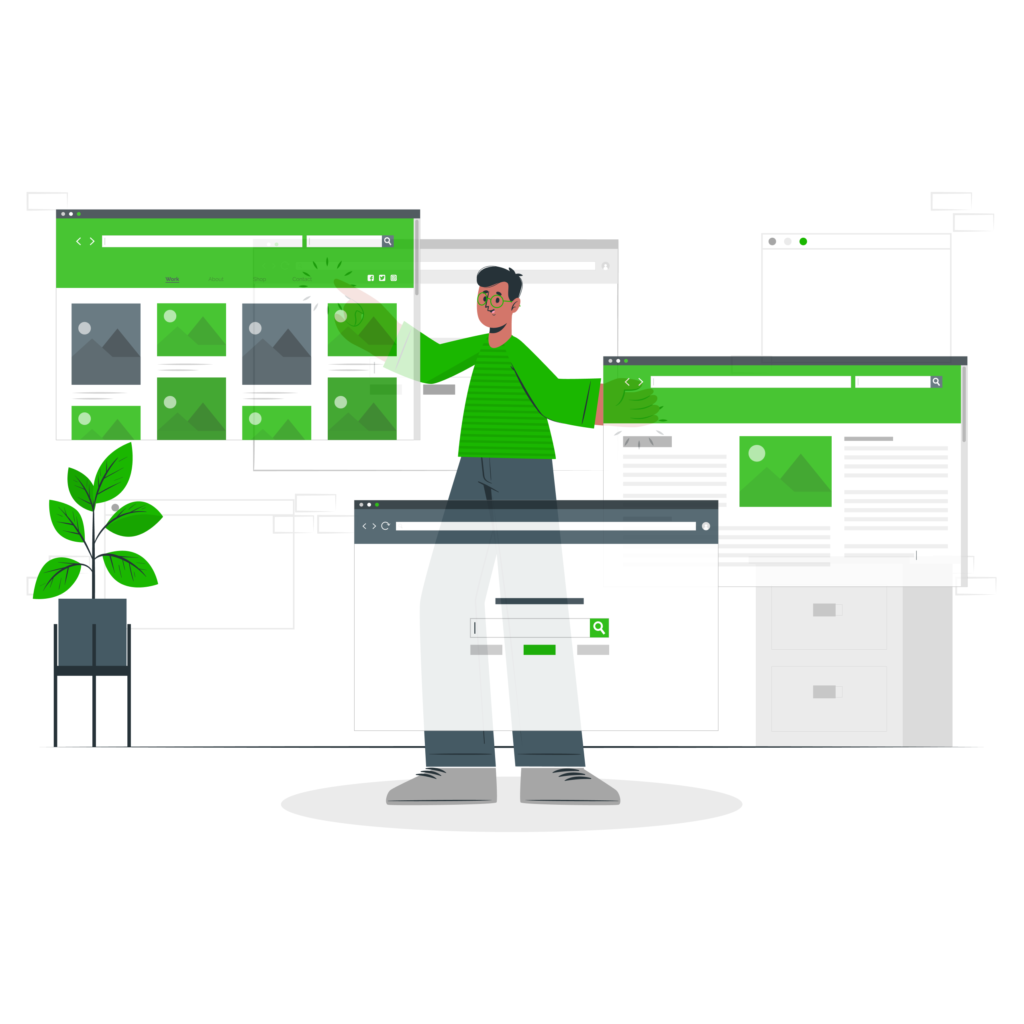Nowadays, web development is quite popular. For businesses to meet consumers’ digital needs, having a well-functioning website or web application is now a prerequisite. In their industry, almost all companies are concentrating on building attractive websites to advertise their products.
However, not all aspects of the web development process include coding. Following a planned approach becomes essential to prevent issues when 100 factors are considered.
A web app development life cycle delivers precisely that: a well-planned technique for achieving excellent results. To create a unique website, you must adhere to the seven phases of the web development life cycle.
We’ll be going over every step on the website development checklist and each phase of the web application development in
depth.
Describe web development.
Creating websites and web apps that function online is known as web development. Everything from building a fully-fledged, robust web application and a content management system to a straightforward static one-page website.
The software development life cycle, or SDLC, for creating websites consists of the following:
- 1. The application logic’s code, which incorporates databases and controls user queries creating user interfaces, maintaining and upgrading.
- 2. The website on servers is used to categorize each step in creating a bespoke web program.
Web development layers
1: Server Side
All of the operations that take place in the background of a website are incorporated into backend or server-side development. The essential parts of the backend include the administration of servers, databases, and logical components.
While these are not immediately apparent to consumers, your website would be an empty page with no functionality without a capable backend development team.
2: Client-Side
The front end, another name for this layer, is primarily responsible for the visual appearance and layout of the website. Frontend developers employ CSS, HTML, and JavaScript to build responsive web pages that provide a smooth user experience. Your website can only draw visitors if the user interface is good.
3: Full Stack
Web development is encompassed by full-stack products, which integrate the front and backend. In the website development cycle, you manage this layer’s full stack of duties and techniques.
A full-stack engineer is skilled in UI-UX design, database management, server hosting, and browser code. Together, these three levels make up the web development life cycle. The process is the same for developing websites and web applications.
Knowing the web application development cycle is crucial if you or your team is working on a web project.
What is the life cycle for web development?
Creating a website, from conceiving the idea to coding and designing the website to deploying and managing it, is covered under a web development life cycle. It is the accepted or systematic procedure to create a successful website.
It provides a simple software development life cycle roadmap that a web developer and project manager may follow to achieve the fewest possible mistakes and the best outcomes.
The seven phases of web development are:
- Research
- Planning
- Designing
- Creation of content
- Development
- Testing
- Maintenance.
The Life Cycle of Web Development in 7 Phases
Investigation and analysis
This crucial stage of web development is addressed. Getting information about the project and the customer is essential to ensure your design and development are going correctly.
Your developers can only offer the best solution if they know who they work for and their needs. It’s crucial to picture the demographics of the users your website will serve throughout this time.
Establish objectives and create requirement elicitation papers while considering each person’s age, gender, interests, and requirements. Surveying users about their issues and the solutions they seek frequently produces positive results.
You must assess the viability and profitability of your ideas for web applications. The subsequent phases of web development become ineffective and unable to deliver the expected results if this step is skipped.
Arrangement and Plan
Developing a website includes strategies for the website’s design, technology, content, and promotion. The structure and characteristics of the website are decided upon in light of the data obtained and examined in the previous step.
A committed team is created during the planning phase, and each member is assigned a specific function and set of duties. When building a website, deciding on the content organization, wireframes (schematics and preliminary designs), technological stack, and software development methods are crucial.
Any online application is built using a technology stack, a collection of programming languages, web frameworks, and applications. The Planning phase also involves allocating resources, establishing deliverables, calculating timescales, and creating a sitemap. Before going on to the Design step, you must finally settle on the branding of your website.
Wireframing and design
The UI-UX designers come to the fore during the web design stage, which entails developing the layout of websites. The layout entails creating a quick sketch, which might be graphical, to obtain a sense of the website’s style. The design aims to create an informational framework so clients can visualize the fundamental features and content.
The wireframe created in the previous step is translated into buttons, tabs, menus, dashboards, color schemes, typography, and images to develop the website’s basic structure.
Create an interactive website that meets the target audience’s tastes and needs while keeping the research in mind. Keep your website and application from lapsing into redundancy. To draw visitors, employ images, colors, and other media without departing from the theme and goal of your website.
Creation of Content
Content reigns supreme in the end. No amount of sophisticated design can help you if you are unable to interact with your readers and consumers.
The primary goal of the content generation stage is to establish a communication channel through the user interface.
Content writing entails presenting essential information about your business in a clear, appealing manner. The web development life cycle includes adding calls to action, crafting catchy headlines, formatting, line editing, composing, and updating content.
In this stage, your website’s branding and marketing are developed, and you may define your website’s goals through content creation. Content is the only method to communicate with end users and convert them into customers. Pay close attention to user problems and the answers you can provide.
Development and Coding
The actual construction of the website is done during the development phase. In this stage, the client-side and server-side development of the website is completed. It takes up the most time during the website creation process.
Developing front-end websites
Early in creating a web page, it is agreed that interactive components are incorporated. Web designers use web frameworks and development tools to add parts and functionalities to the website’s structure.
The web designer uses HTML, CSS, and a programming language typically JavaScript to construct user-friendly websites. Bootstrap and Foundation are chosen for most online projects’ frontend HTML and CSS development.
There are several front-end frameworks for JavaScript on the market. (For additional details, see our blog post on the top front-end web development frameworks.)
A mobile version of your website is also advised if you wish to stay current with industry trends. An excellent choice is to build your website with mobile users in mind or to create a mobile application.
Back-end Web Development
This stage involves creating the web app’s actual functionalities. The backend programs the instructions to make each piece do the critical functions, while the front completes the visual elements and deals with the user side.
Creating databases, designing application logic, and combining server- and client-side operations are all included in developing a server-side application. In this stage, developers work with various technologies and programming languages.
SEO has been included in the list of responsibilities for backend engineers. Adding these elements can help your site rank higher in search engines like Google.
Quality control and testing
When the website is created, thorough tests are run to find and fix flaws. The QA team thoroughly tests the web app’s operation, usability, compatibility, and performance using unit, stress, integration, and load testing.
Project consistency is crucial for a website to operate correctly and offer a seamless user experience. Testing how well these functionalities function across all platforms and devices is vital.
In addition, making minor adjustments like SEO optimization and plugins will ensure a flawless launch. Testing engineers and developers collaborate continuously until the QA team certifies that the finished website is prepared for user deployment.
We advise commencing the testing process as soon as feasible to save time and money in the latter phases. Let the QA team create tests while the wireframes are being made. Doing so may avoid the need for several testing and development cycles and substantial design modifications.
Deployment and Support
The website or app is fully prepared for distribution after you have the QA team’s seal of approval. The software is hosted on the web servers and made accessible to visitors via File Transfer Protocol.
Yet the job still needs to be done. You may identify areas for development using ongoing feedback from user engagement. The web application development life cycle is done to make the required changes.
In addition, ongoing upkeep and upgrades are essential to keep the site operating flawlessly and attracting new visitors. The daily upkeep of your website may fall into your hands if you hire a web development firm or bespoke website, developers.
In such circumstances, be careful not to overlook post-deployment maintenance services. Regardless of how small or large the project is, each stage of the programming life cycle is essential.
Although coding is a crucial component of any software development project, it’s also essential to take additional measures, such as design, content creation, security checks, and quality assurance team testing, in creating a website. The lifespan of creating a website is an ongoing process that may constantly improve.
Conclusion
Creating web applications is a complicated procedure that must be done to provide good outcomes. Each business deviates from the typical timeframe for web development, adding or eliminating phases as necessary for their project.
The web development method changed by your project management approach. Yet, for every website development job, acquiring pertinent information and proper preparation are crucial.
FAQs
Which stage of the web development life cycle is the most crucial?
Every stage of the website creation procedure is essential. The website addresses if any coding or maintenance phases are addressed. However, the first stage is typically seen as vital because it entails understanding the client’s needs and getting off to a false start, which may result in wasted months of labor.
How do you turn a good concept into a website?
A sound concept has to be supported by appropriate research to be turned into a good website or online application. You may build a high-performing site with a solid business concept, thorough research, a talented team of developers, and strict testing procedures. Also, it’s critical to stay current with your website design and follow the latest trends in web development.
Are there differences between web pages and web applications?
Sure, several technologies operate online. A web app is a software program that can be accessed using web browsers but runs on an application server instead of a website, a collection of web pages that function on a web server. Nonetheless, with a few minor modifications, the software development life cycle is primarily unchanged for websites and web apps.

